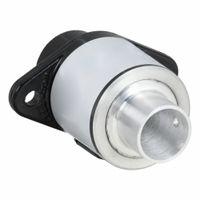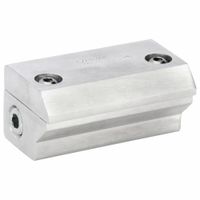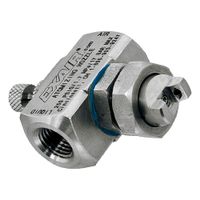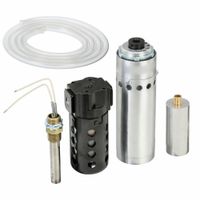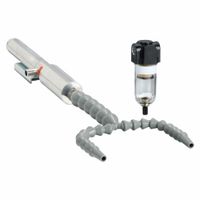Call +(254) 703 030 000 / 751 483 999 / 721 704 777
- Home
- Pneumatics
- Pneumatic Coolers Air Knives
.....Read More
Frequently Asked Questions
What are pneumatic coolers and how do they work?
Pneumatic coolers are devices used to reduce the temperature of compressed air in pneumatic systems. They are essential in maintaining the efficiency and longevity of pneumatic equipment by preventing overheating and removing moisture from the air.
These coolers typically work by using a heat exchanger, where the hot compressed air passes through a series of tubes or plates. A cooling medium, often ambient air or water, flows around these tubes or plates, absorbing the heat from the compressed air. This process reduces the air temperature to a more manageable level before it enters the pneumatic system.
There are two main types of pneumatic coolers: air-cooled and water-cooled. Air-cooled pneumatic coolers use fans to blow ambient air over the heat exchanger, dissipating the heat. They are generally easier to install and maintain, making them suitable for environments where water is scarce or where simplicity is desired. Water-cooled pneumatic coolers, on the other hand, use water as the cooling medium. They are more efficient in heat transfer and are ideal for applications requiring significant cooling or where ambient air temperatures are high.
The cooling process also helps in condensing and removing moisture from the compressed air. As the air cools, its capacity to hold moisture decreases, causing water vapor to condense into liquid form. This condensate is then removed from the system using moisture separators or drains, ensuring that the air entering the pneumatic system is dry.
Overall, pneumatic coolers are crucial for optimizing the performance and reliability of pneumatic systems by controlling air temperature and moisture content.
How do air knives improve production processes?
Air knives improve production processes by providing efficient, non-contact drying, cleaning, and cooling solutions. They utilize high-velocity air streams to remove moisture, debris, or heat from products on a production line, enhancing product quality and consistency.
1. **Drying Efficiency**: Air knives effectively remove water or other liquids from surfaces, crucial in industries like food processing, automotive, and electronics. This ensures products are dry before packaging or further processing, reducing defects and improving shelf life.
2. **Cleaning Capability**: By blowing off dust, particles, or contaminants, air knives maintain product cleanliness without physical contact. This is particularly beneficial in industries requiring high hygiene standards, such as pharmaceuticals and food production.
3. **Cooling Applications**: Air knives can rapidly cool products by directing a stream of air over hot surfaces. This is essential in processes like extrusion or molding, where quick cooling can enhance product integrity and reduce cycle times.
4. **Energy Efficiency**: Compared to traditional drying or cleaning methods, air knives consume less energy. They use compressed air efficiently, reducing operational costs and environmental impact.
5. **Non-Contact Process**: The non-contact nature of air knives prevents damage to delicate or sensitive products, maintaining their structural integrity and appearance.
6. **Versatility and Customization**: Air knives can be tailored to specific applications, with adjustable air flow and pressure settings. This flexibility allows them to be integrated into various production lines, accommodating different product sizes and shapes.
7. **Increased Throughput**: By speeding up drying, cleaning, and cooling processes, air knives contribute to faster production rates, enhancing overall throughput and productivity.
In summary, air knives streamline production processes by providing efficient, versatile, and cost-effective solutions for drying, cleaning, and cooling, ultimately improving product quality and operational efficiency.
What are the benefits of using air wipes in manufacturing?
Air wipes offer several benefits in manufacturing processes:
1. **Efficient Cleaning**: Air wipes use high-velocity air streams to remove debris, dust, and moisture from products, ensuring a clean surface without physical contact. This is particularly useful for delicate or sensitive materials.
2. **Non-Contact Drying**: They provide a non-contact method of drying, which is essential for products that could be damaged by physical contact or abrasion. This is ideal for items like wires, cables, and extruded products.
3. **Cost-Effective**: By reducing the need for consumables like towels or brushes, air wipes lower operational costs. They also minimize maintenance and replacement costs associated with wear and tear on physical cleaning tools.
4. **Improved Product Quality**: Consistent and thorough cleaning and drying improve the overall quality of the finished product, reducing defects and enhancing customer satisfaction.
5. **Increased Production Speed**: Air wipes can be integrated into production lines, allowing for continuous processing without the need for manual intervention, thus speeding up production times.
6. **Energy Efficiency**: Modern air wipe systems are designed to be energy-efficient, using less compressed air while maintaining high performance, which reduces energy costs.
7. **Versatility**: They can be used across various industries and applications, from automotive to electronics, due to their adaptability to different shapes and sizes of products.
8. **Enhanced Safety**: By eliminating the need for manual cleaning, air wipes reduce the risk of worker injury and exposure to hazardous materials.
9. **Environmental Benefits**: Reducing the use of water and chemicals in cleaning processes makes air wipes an environmentally friendly option, contributing to sustainable manufacturing practices.
How do air amplifiers differ from other pneumatic cooling devices?
Air amplifiers differ from other pneumatic cooling devices primarily in their mechanism of operation, efficiency, and applications.
Air amplifiers use the Coandă effect to entrain ambient air, significantly multiplying the volume of air output compared to the compressed air input. This results in a high-velocity, high-volume airflow that can be used for cooling, drying, or ventilating. They are efficient because they require less compressed air to produce a large volume of output air, making them cost-effective and energy-efficient.
In contrast, other pneumatic cooling devices like vortex tubes operate on a different principle. Vortex tubes separate compressed air into hot and cold streams through a spinning motion, providing spot cooling without moving parts. While effective for specific applications, vortex tubes are generally less efficient in terms of air consumption compared to air amplifiers.
Air amplifiers are also distinct from air knives, which are designed to produce a flat, high-velocity sheet of air for applications like drying or cleaning surfaces. Air knives are effective for targeted applications but do not amplify air volume to the same extent as air amplifiers.
In terms of applications, air amplifiers are versatile and can be used for cooling, exhausting fumes, or conveying materials. Their ability to amplify air volume makes them suitable for large-scale cooling or ventilation tasks. Other pneumatic devices may be more specialized, such as vortex tubes for spot cooling or air knives for surface drying.
Overall, air amplifiers offer a unique combination of high efficiency, versatility, and simplicity, setting them apart from other pneumatic cooling devices.
What applications are cold air guns best suited for?
Cold air guns are best suited for applications that require localized cooling without the use of liquid coolants. They are particularly effective in the following scenarios:
1. **Machining and Tool Cooling**: Cold air guns are ideal for cooling cutting tools in CNC machines, lathes, and mills. They help in extending tool life, improving surface finish, and preventing heat-related damage to both the tool and the workpiece.
2. **Spot Cooling**: In manufacturing processes where specific areas need to be cooled rapidly, such as during welding or soldering, cold air guns provide precise cooling to prevent heat distortion and maintain material integrity.
3. **Electronic Component Cooling**: They are used to cool electronic components during testing or operation, preventing overheating and ensuring optimal performance and longevity of sensitive parts.
4. **Adhesive Setting**: Cold air guns can accelerate the setting of adhesives by cooling the area, which is beneficial in assembly lines where quick bonding is required.
5. **Plastic and Rubber Processing**: In processes like injection molding, cold air guns help in cooling molds and parts quickly, reducing cycle times and improving production efficiency.
6. **Laboratory and Testing Environments**: They are used in labs for cooling samples or equipment without introducing moisture, which is crucial for maintaining the integrity of experiments.
7. **Food and Beverage Industry**: Cold air guns can be used to cool products or packaging lines, ensuring that temperature-sensitive items remain within safe temperature ranges.
8. **Textile Industry**: They help in cooling sewing needles and other equipment, preventing heat buildup that can lead to material damage or equipment malfunction.
Overall, cold air guns are versatile tools that provide efficient, dry, and precise cooling in various industrial and laboratory settings.
How do vortex tubes achieve rapid temperature reduction?
Vortex tubes achieve rapid temperature reduction through a process called the Ranque-Hilsch effect. When compressed air is injected tangentially into the vortex tube, it creates a high-speed rotational flow. This flow separates into two distinct streams: a hot outer stream and a cold inner stream. The separation occurs due to the conservation of angular momentum and energy distribution within the tube.
As the air spins rapidly, centrifugal forces push the warmer, faster-moving air molecules towards the outer edges of the tube, while the cooler, slower-moving molecules remain near the center. The outer stream, which is at a higher temperature, exits through a control valve at one end of the tube. Meanwhile, the inner stream, which is cooler, is directed out of the opposite end.
The temperature difference between the two streams is a result of the energy transfer that occurs during the separation process. The outer stream loses energy as it moves towards the periphery, while the inner stream gains energy, resulting in a temperature drop. By adjusting the control valve, users can regulate the proportion of air exiting from each end, thus controlling the temperature and flow rate of the cold air stream.
Vortex tubes are advantageous because they have no moving parts, require no electricity, and are compact and lightweight. They are used in various industrial applications for spot cooling, such as cooling electronic components, machining operations, and laboratory experiments.
What are the advantages of using cabinet and enclosure vortex coolers?
Cabinet and enclosure vortex coolers offer several advantages:
1. **Efficient Cooling**: Vortex coolers use compressed air to generate cold air through a vortex tube, effectively cooling enclosures without the need for refrigerants or complex machinery.
2. **Maintenance-Free**: With no moving parts, vortex coolers require minimal maintenance, reducing downtime and operational costs.
3. **Compact Design**: Their small size allows for easy installation in tight spaces, making them ideal for retrofitting existing enclosures.
4. **Cost-Effective**: They are generally less expensive to purchase and operate compared to traditional air conditioning systems, especially in environments where compressed air is readily available.
5. **Durability**: Made from robust materials, vortex coolers can withstand harsh industrial environments, including high temperatures and corrosive conditions.
6. **Consistent Performance**: They provide a steady stream of cold air, ensuring consistent cooling performance and protecting sensitive electronic components from overheating.
7. **Environmentally Friendly**: Vortex coolers do not use harmful refrigerants, making them an eco-friendly cooling solution.
8. **Quick Installation**: Easy to install with minimal setup time, they can be quickly deployed to address urgent cooling needs.
9. **Versatility**: Suitable for a wide range of applications, including electrical cabinets, control panels, and other enclosures in various industries.
10. **Safety**: By maintaining a positive pressure inside the enclosure, vortex coolers help prevent the ingress of dust, dirt, and moisture, enhancing the safety and reliability of the equipment.
11. **Energy Efficiency**: They can be more energy-efficient in specific applications, particularly where intermittent cooling is required, as they can be turned on and off quickly without the need for a cooldown period.
These advantages make vortex coolers a practical choice for many industrial cooling applications.
How do you choose the right pneumatic cooler for your application?
To choose the right pneumatic cooler for your application, consider the following factors:
1. **Application Requirements**: Determine the specific cooling needs of your application, including the type of pneumatic system, the operating environment, and the desired temperature reduction.
2. **Cooling Capacity**: Assess the heat load that needs to be dissipated. Calculate the required cooling capacity in BTU/hr or kW to ensure the cooler can handle the thermal demands.
3. **Air Flow Rate**: Evaluate the necessary air flow rate, measured in CFM (cubic feet per minute) or m³/h, to ensure efficient heat exchange. Match the cooler's capacity with the system's air flow requirements.
4. **Operating Pressure**: Check the operating pressure of your pneumatic system. Ensure the cooler is compatible with the system's pressure range to maintain optimal performance and safety.
5. **Ambient Conditions**: Consider the environmental conditions, such as ambient temperature, humidity, and potential exposure to corrosive elements. Choose a cooler with materials and coatings suitable for the environment.
6. **Size and Space Constraints**: Evaluate the available space for installation. Select a cooler that fits within the spatial constraints without compromising performance.
7. **Energy Efficiency**: Look for energy-efficient models that minimize power consumption while providing effective cooling. This can reduce operational costs and environmental impact.
8. **Maintenance and Reliability**: Consider the ease of maintenance and the reliability of the cooler. Opt for models with a proven track record and accessible service options.
9. **Cost**: Balance the initial investment with long-term operational costs. Consider the total cost of ownership, including maintenance, energy consumption, and potential downtime.
10. **Compliance and Standards**: Ensure the cooler meets industry standards and regulations relevant to your application, such as ISO, ASME, or CE certifications.
By carefully evaluating these factors, you can select a pneumatic cooler that meets your specific application needs efficiently and cost-effectively.
What maintenance is required for pneumatic cooling systems?
Maintenance for pneumatic cooling systems involves several key tasks to ensure optimal performance and longevity:
1. **Regular Inspection**: Conduct routine checks for leaks in hoses, fittings, and connections. Inspect the system for any signs of wear, corrosion, or damage.
2. **Filter Maintenance**: Clean or replace air filters regularly to prevent dust and debris from entering the system, which can cause blockages and reduce efficiency.
3. **Lubrication**: Ensure that all moving parts are properly lubricated to minimize friction and wear. Use the manufacturer-recommended lubricants.
4. **Pressure Check**: Monitor and adjust the system's pressure settings to ensure they are within the specified range. Incorrect pressure can lead to inefficiencies or damage.
5. **Valve and Actuator Maintenance**: Inspect and test valves and actuators for proper operation. Clean or replace them if they are not functioning correctly.
6. **Drainage**: Regularly drain moisture from air receivers and lines to prevent water accumulation, which can lead to corrosion and freezing in colder environments.
7. **Temperature Monitoring**: Keep an eye on the system's operating temperature to ensure it remains within the recommended range. Overheating can cause damage to components.
8. **Calibration**: Periodically calibrate sensors and controls to maintain accurate system performance and efficiency.
9. **Component Replacement**: Replace worn or damaged components promptly to prevent system failures. Keep a stock of essential spare parts for quick replacements.
10. **Documentation**: Maintain detailed records of all maintenance activities, including inspections, repairs, and replacements, to track the system's history and plan future maintenance.
11. **Training**: Ensure that personnel responsible for maintenance are adequately trained and familiar with the system's operation and maintenance procedures.
By adhering to these maintenance practices, pneumatic cooling systems can operate efficiently, reduce downtime, and extend their service life.
How do pneumatic coolers contribute to energy efficiency in industrial settings?
Pneumatic coolers contribute to energy efficiency in industrial settings by utilizing compressed air systems to provide cooling without the need for additional electrical energy. These systems leverage the expansion of compressed air to produce a cooling effect, which can be used to maintain optimal operating temperatures for machinery and processes. This method reduces the reliance on traditional electrically powered cooling systems, thereby lowering overall energy consumption.
The efficiency of pneumatic coolers is enhanced by their ability to integrate seamlessly with existing compressed air systems, which are already prevalent in many industrial environments. By using the same air supply, they eliminate the need for separate cooling infrastructure, reducing both capital and operational costs. Additionally, pneumatic coolers are often more compact and require less maintenance than conventional cooling systems, further contributing to cost savings and energy efficiency.
Moreover, pneumatic coolers can be strategically deployed to target specific areas or equipment that require cooling, rather than cooling entire spaces. This targeted approach minimizes energy waste and ensures that only the necessary areas are cooled, optimizing energy use. The rapid response time of pneumatic coolers also allows for quick adjustments to changing thermal loads, maintaining efficiency even under varying operational conditions.
In summary, pneumatic coolers enhance energy efficiency in industrial settings by utilizing existing compressed air systems, reducing the need for additional electrical energy, minimizing infrastructure and maintenance costs, and providing targeted, responsive cooling. This contributes to lower energy consumption, reduced operational costs, and improved sustainability in industrial operations.
